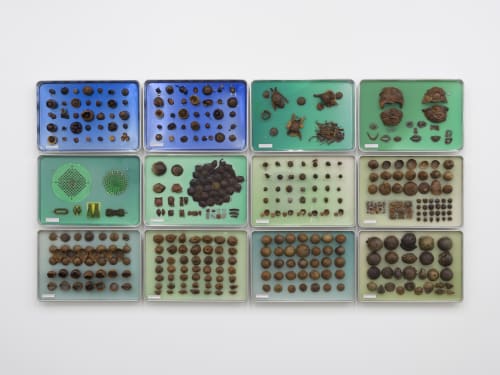LOS ANGELES — There is an uncanny feeling entering Philip Martin gallery, where Human Nature, a solo exhibition featuring sculptural and wall-based work by prolific post-minimalist artist Carl Cheng — often known through his corporate-mocking moniker John Doe Co. — is currently on view. I felt as though I’d entered behind the scenes of an experimental laboratory, where 30-year-old Wonder bread (“Erosian Landscape Bread Print No. 33,” 1979) and orderly assemblages of resin-bound avocado skins in metal cafeteria trays (“Nature Laboratory Collection 3.0,” 1970–2022) formed odd arrangements on the walls, while the commanding “Organic Visualizer/Assembler” (1970–2016), a foreboding steel sculpture that holds a rotating drum lit by interactive fluorescent lights, occupied the floor space.
The exhibition, a survey of decades of work by the Southern California native — including the coin-operated console from his well-known public artwork, “Natural Museum of Modern Art,” installed at the Santa Monica Pier in 1979 — is also a study in natural and human-made systems, undoing the false binary between nature and culture by wielding them indiscriminately as material. Circuit boards, monitors, plants, and rocks all exist on a level playing field here. Cheng manipulates each one in unique ways to conduct subtle experiments in psychology and underscore the patterns, hypocrisies, and delights of human nature. His work maintains a sense of humor that leaves it open to multiple interpretations, letting materials speak for themselves and never giving into didacticism, despite toying with the territory of scientific inquiry.
Take “Alternative TV #5” (1974), a red LED-lit diorama featuring miniature plastic plants and conglomerated rocks inside a plastic television chassis. Or “Anthropocene Landscape 2” (2016): What appears to be an agrarian landscape as seen from a plane is a tightly constructed grid of printed circuit boards and rivets on aluminum. In the exhibition’s press release, the artist comments that “our computer technology is very primitive. It is all straight lines. Our human landscape is also straight lines … What we do in our computer is what we do in our landscape, driving our cars, etc …” “Anthropocene Landscape 2” exemplifies the larger dissolution of the nature/culture binary in Cheng’s work, in this case alongside a collapse of micro/macro scales. Whether through our agricultural interventions into the landscape or computer design, Cheng highlights the parallels in the ways we move through our technologies, be it across our maps or our hard drives.
Cheng is equal parts inventor and artist, creating new machinery (forged from his background studying industrial design at UCLA in the ’60s) to embody new ideas, breaking both technological and cultural ground as a Chinese-American artist, whose parents hail from the Guangdong province of Southern China. The steel and acrylic form of “Organic Visualizer/Assembler” is one such of Cheng’s sculptural inventions. Based on the iron lung, a suffocating apparatus once used as a mechanical respirator to stimulate breathing — the irony and terror of which is not lost on the artist — the body-sized structure holds a rotating, vaguely cosmic landscape within, punctuated by what the press-release refers to as “human-made specimen objects” and organic material connected by geometrical arrangements of lines, like a map of the stars. The viewer is invited to press on a number of green buttons to see these objects in different light, which vary from the abstract to the planet-like to the pseudo-biological, a cabinet of curiosities that resembles science museum displays. Like his public coin-operated works, which considered the psychology behind getting passerby to commit to interactive work by “paying for what they get” (to paraphrase the artist), the buttons undermine our expectation for the spectacular, offering only a light source without shedding any real light on the use-value or underlying meaning of what we can observe.
On the gallerist’s desk, an even more discreet piece awaits: “Twin Rock Communication Indicator” (1983). Inside an unassuming brown briefcase, two red wires connected to an electronic meter sit beside three rocks of varying sizes. Text lining the case proclaims the work to be a “… simulated instrument for testing the concept that rocks … have the ability to communicate with themselves.” A gallery attendant and I each held a red wire to a rock, and the machine came to life with a hushed whirring sound, the dial on the meter shifting in sporadic bursts. I had the feeling the rocks were telling each other a similar story as the other works in the show: that all material on Earth can communicate — but how we interpret their message(s) is up to us.


